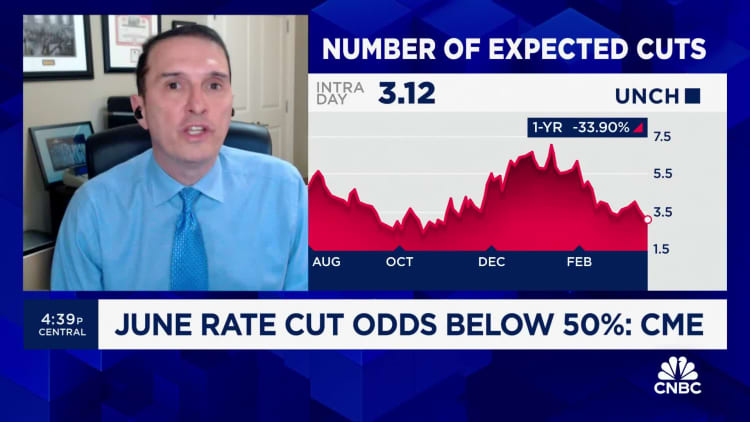The Federal Reserve holds interest rates steady, with no immediate relief for consumers from sky-high borrowing costs
5 min read

The Federal Reserve announced Wednesday it will leave interest rates unchanged, delaying the possibility of rate cuts as well as any relief from sky-high borrowing costs.
Overall, expectations that the Fed is pulling off a soft landing have increased, but that offers little consolation for Americans with high-interest debt.
And now there may be fewer interest rate cuts on the horizon after hotter-than-expected inflation reports sent the message that “we are moving in the right direction, but we’re not there yet,” said Greg McBride, chief financial analyst at Bankrate.com.
For consumers, that means “a very slow downward drift in savings rates but no material change in borrowing costs for credit cards, auto loans or home equity lines of credit,” McBride said.
More from Personal Finance:
Here’s when the Fed is likely to start cutting interest rates
Nearly half of young adults have ‘money dysmorphia’
Deflation: Here’s where prices fell
Inflation has been a persistent problem since the Covid-19 pandemic, when price increases soared to their highest levels since the early 1980s. The Fed responded with a series of interest rate hikes that took its benchmark rate to its highest level in more than 22 years.
The federal funds rate, which is set by the U.S. central bank, is the interest rate at which banks borrow and lend to one another overnight. Although that’s not the rate consumers pay, the Fed’s moves still affect the borrowing and savings rates they see every day.
The spike in interest rates caused most consumer borrowing costs to skyrocket, putting many households under pressure.
Even with some rate cuts on the horizon later this year, consumers won’t see their borrowing costs come down significantly, according to Columbia Business School economics professor Brett House.
“The costs of borrowing will remain relatively tight in real terms as inflation pressures continue to ease gradually,” he said.
From credit cards and mortgage rates to auto loans and savings accounts, here’s a look at where those rates could go in 2024.
Credit cards
Since most credit cards have a variable rate, there’s a direct connection to the Fed’s benchmark. In the wake of the rate hike cycle, the average credit card rate rose from 16.34% in March 2022 to nearly 21% today — an all-time high.
With most people feeling strained by higher prices, balances are higher and more cardholders are carrying debt from month to month compared with last year.
Annual percentage rates will start to come down when the Fed cuts rates, but even then they will only ease off extremely high levels. With only a few potential quarter-point cuts on deck, APRs would still be around 20% by the end of 2024, according to Ted Rossman, Bankrate’s senior industry analyst.
“If the average credit card rate falls a percentage point from its current record high of 20.75%, most cardholders would barely notice,” he said.
Mortgage rates
Although 15- and 30-year mortgage rates are fixed, and tied to Treasury yields and the economy, anyone shopping for a new home has lost considerable purchasing power, partly because of inflation and the Fed’s policy moves.
But rates are already lower since hitting 8% in October. Now, the average rate for a 30-year, fixed-rate mortgage is near 7%. That’s up from 4.4% when the Fed started raising rates in March 2022 and 3.27% at the end of 2021, according to Bankrate.
Doug Duncan, chief economist at Fannie Mae, expects mortgage rates will end the year at 6.4%, but that won’t provide much of a boost for would-be homebuyers.
“The housing market is likely to continue to face the dual affordability constraints of high home prices and elevated interest rates in 2024,” Duncan said. “The problem is still supply. If rates come down and it ramps up demand and there’s no supply, the only thing that happens is that home prices go up.”
Auto loans
Even though auto loans are fixed, payments are getting bigger because car prices have been rising along with the interest rates on new loans, resulting in less affordable monthly payments.
The average rate on a five-year new car loan is now more than 7%, up from 4% when the Fed started raising rates, according to Edmunds. However, competition between lenders and more incentives in the market have started to take some of the edge off the cost of buying a car lately, said Ivan Drury, Edmunds’ director of insights.
Once the Fed cuts rates, “that gives people a little more breathing room,” Drury said. “Last year was ugly all around. At least there’s an upside this year.”
Student loans
Federal student loan rates are also fixed, so most borrowers aren’t immediately affected. But undergraduate students who take out new direct federal student loans are now paying 5.50% — up from 4.99% in the 2022-23 academic year and 3.73% in 2021-22.
Private student loans tend to have a variable rate tied to the prime, Treasury bill or another rate index, which means those borrowers are already paying more in interest. How much more, however, varies with the benchmark.
For those struggling with existing debt, there are ways federal borrowers can reduce their burden, including income-based plans with $0 monthly payments and economic hardship and unemployment deferments.
Private loan borrowers have fewer options for relief — although some could consider refinancing once rates start to come down, and those with better credit may already qualify for a lower rate.
Savings rates
While the central bank has no direct influence on deposit rates, the yields tend to be correlated to changes in the target federal funds rate.
As a result, top-yielding online savings account rates have made significant moves and are now paying more than 5% — above the rate of inflation, which is a rare win for anyone building up an emergency savings account, McBride said.
Since those rates have likely maxed out, this is the time to lock in certificates of deposit, especially maturities longer than one year, he said. “There’s no incentive to hold out for something better because that’s not the way the wind is blowing.”
Currently, one-year CDs are averaging 1.73%, but top-yielding CD rates pay over 5%, as good as or better than a high-yield savings account.







